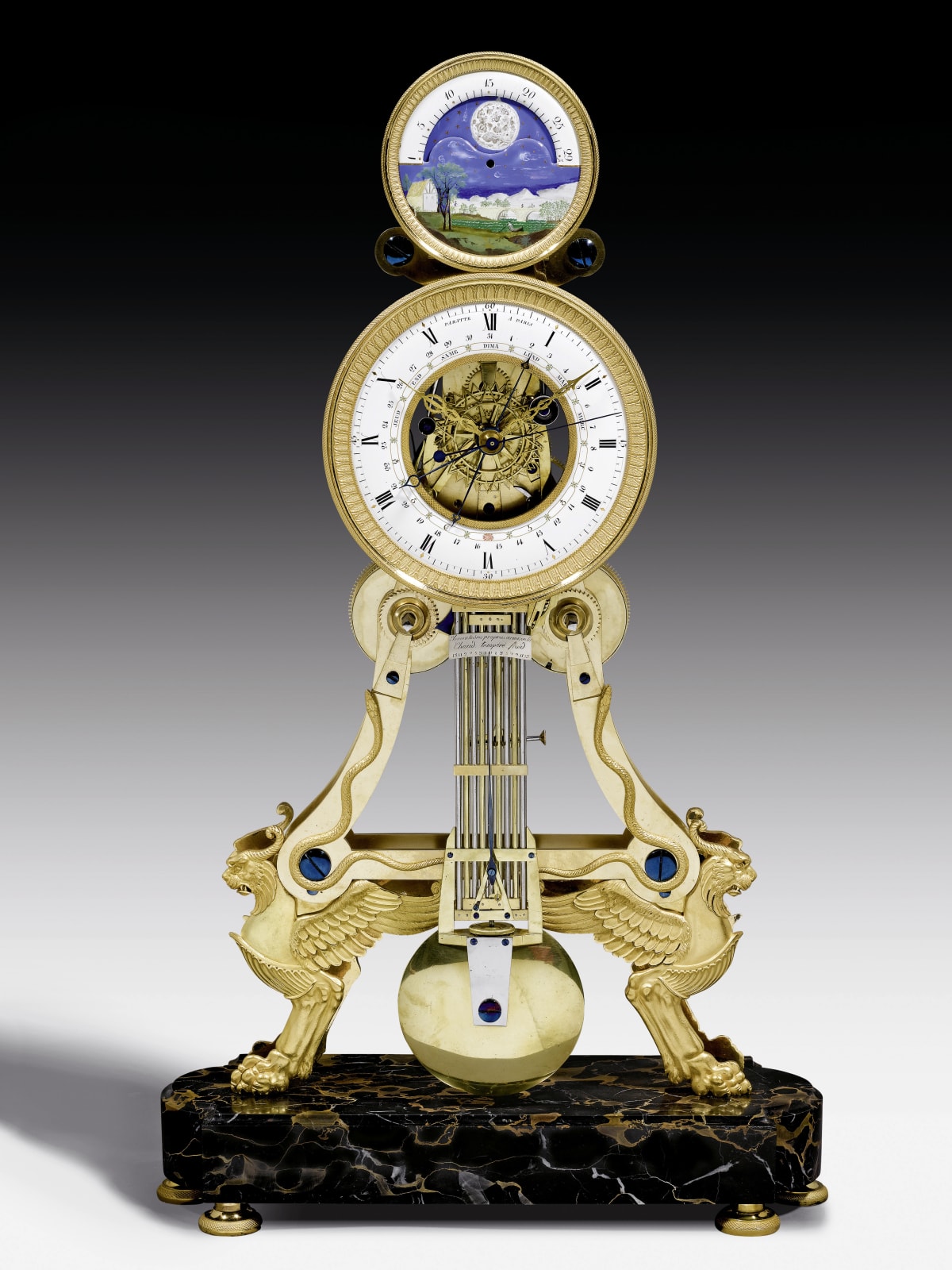Paratte
Provenance
From an Italian private collection.
Literature
Tardy, "Les Plus Belles Pendules Françaises", 1994, p. 326, illustrating a very similar clock by Bosset à Paris from the P. Balmès collection and p. 327, illustrating another skeleton clock with the same chimera supports but with additional dials, formerly from the Refes collection. Derek Roberts, "Continental and American Skeleton Clocks", 1989, p. 60, pl. 46a, illustrating an unsigned skeleton clock possibly by Verneuil with fine enamel work by Joseph Coteau, featuring the same inverted Y-shaped frame but without the chimera supports, a fine gilt painted white enamel main dial ring surmounted by a blue and gold star studded lunar dial with two additional subsidiary calendar dials below the main dial, again as here it has a massive gridiron pendulum which unusually is mounted on the front of the clock and again as here the whole stands upon a marble plinth.
An extremely fine and large Directoire/Empire gilt bronze, gilt brass and portoro marble skeleton clock of eight day duration with moon phase signed on the white enamel dial ring Paratte à Paris. The main white enamel dial ring, with a fine gilt bronze foliate bezel, with Roman numerals for the hours and Arabic numerals 15/30/45/60 interspersed by indications for the outer minutes, with a calendar ring for the 31 days of the month and inner ring marked with the days of the week and corresponding deity symbols below, with a very fine pair of pierced gilt brass hands for the hours and minutes, blued steel pointers for the sweep centre seconds and calendar indications, the cut-out dial centre to reveal the elaborate skeletonised movement, the main dial surmounted by a very fine lunar dial with conforming foliate gilt bronze bezel, centred by a beautiful polychrome painted enamel dial face showing a grisaille moon against a blue and gold star studded sky above a painted landscape with a building beside a bridge over a river and figure in a boat, with an outer white enamel ring marked above with Arabic numerals for the 29 ½ days of the lunar month.
The exceptionally fine movement with pin wheel escapement, striking on the half hour on a bell, with a massive nine rod gridiron compensated pendulum mounted with temperature plaque above a large brass bob. The finely polished inverted Y-shaped gilt brass frame mounted with a pair of gilt bronze serpents, resting on four gilt bronze chimeras on a rectangular portoro marble base with rounded ends on turned gilt bronze feet
Paris, date circa 1795-1805
Height 69 cm, width 40 cm, depth 17 cm.
Almost identical clocks with variations to the individual elements were made by such esteemed makers as Verneuil à Dijon, Schmitz à Paris, A. Jaquin Fils à Paris, as well as Lepaute, such as that from the Tronchin collection at Château de Bessinge, near Geneva. Despite its quality surprisingly little is known of the Parisian clockmaker Paratte; Tardy notes that by 1812 a pendulier of this name was established at Barrière Saint-Jacques.
Skeleton clocks, in which the case and dial has been cut away to display the mechanism, are among some of the most prized scientific works of art. French skeleton clocks first began appearing during the mid eighteenth century, predominantly as a result of a wealth of the very finest Paris makers who were eager to display their technical abilities to best advantage. Such clocks were very expensive and were only intended for the elite, who were keen to display these works of art and thus encouraged even greater ingenuity of behalf of the clockmaker. While the evolution of the French skeleton clock occurred gradually and achieved its best period from about 1750-1830, English clockmakers did not begin producing such pieces until about 1820.



